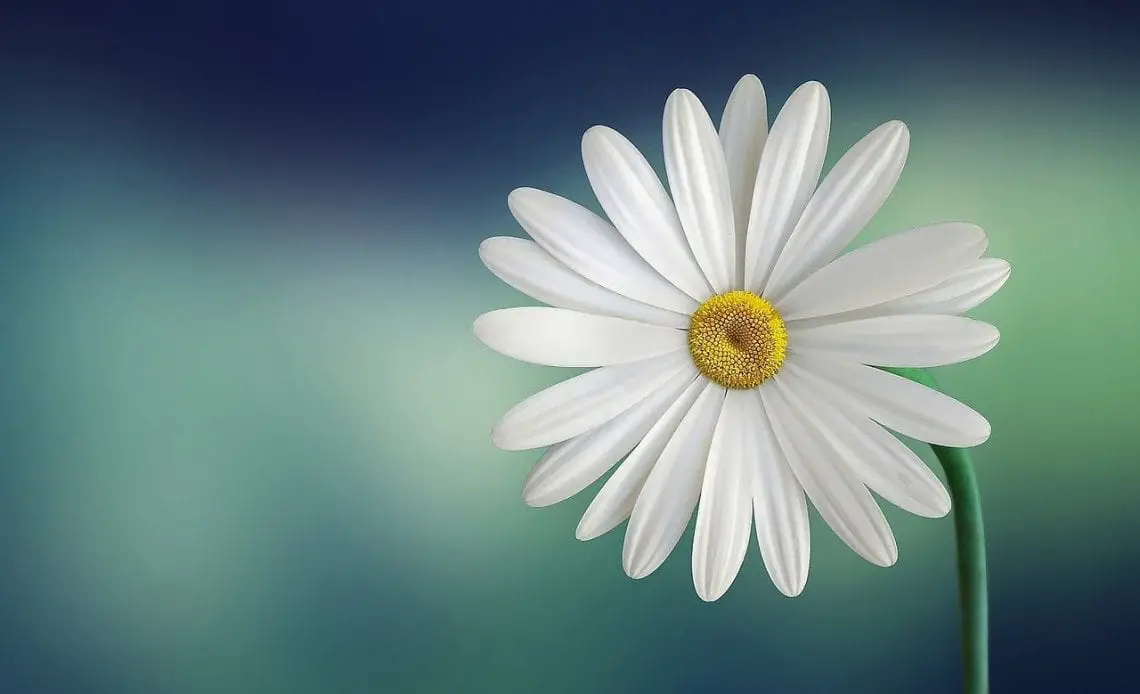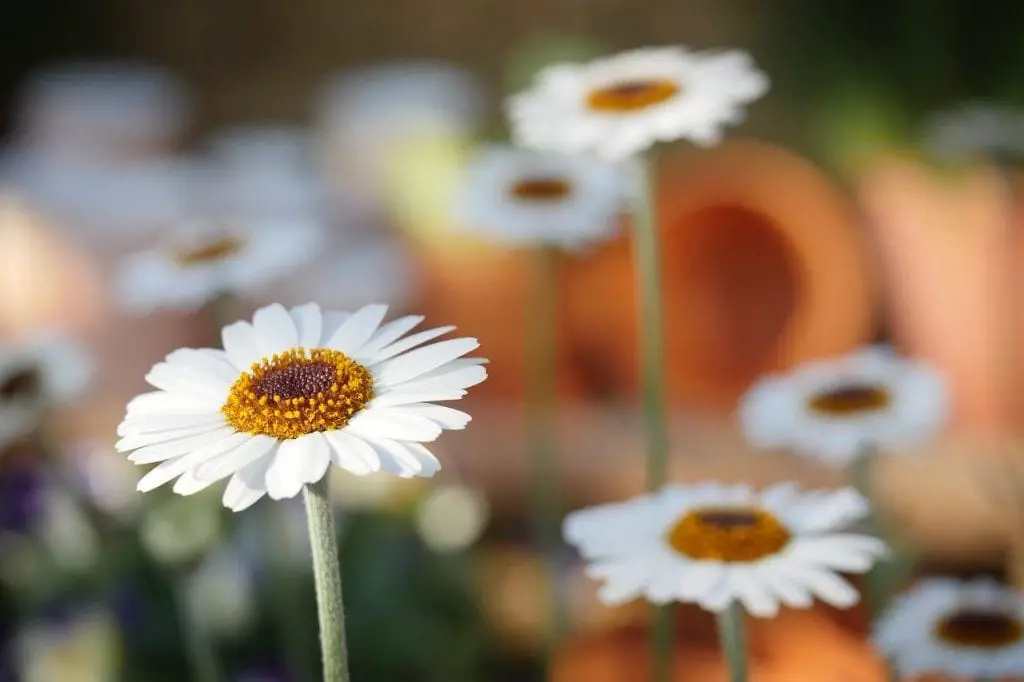
Daisies are a common type of flower found almost everywhere in the world. These flowering plants are mainly cultivated for their aesthetics. However, what many people do not know is that there are different types of daisies. Different species of daisies exist, belonging to different genera with different economic values. There exists daisies which are edible and some even have many medicinal properties. The most common daisy that comes to people’s mind is the English daisy, Bellis perennis.
The term “daisy” came from the translation of an Anglo-Saxon word which means ‘day’s eye’. This is because the flower blooms during the day and closes at night. To know about all the different types of daisies is a mammoth task. However, we can try to know about them by studying their classification.
Description of the Daisy:
The daisy is perennial plant which means its life cycle is for more than two years. They are usually herbaceous and have small, rounded leaves which are shaped like spoons. The flowers of this family of plants are composite. This means that the actual flower that we see is an inflorescence. This inflorescence is made up of two types of florets, the ray florets which are the ones on the periphery and the disc florets in the middle. Another amazing phenomenon exhibited by plants in this family is heliotropism, which means the face of the flower follows the position of the sun.
Classification of Daisies:
The above taxa are the botanical classification given by Linnaeus. It shows the vast expanse of types of daisies. When we use the name daisy, most people think of the classic yellow centered daisy with the white petals. However, there are about 94 different types of common daisies all around the world. Let us dive deeper and try to understand the types of daisies. To do so, we first need to learn about the family which encompasses this plant, Asteraceae family. This family of plants has over 1500 genera of plants and 23,000 species. It is considered the largest flowering family in the plant kingdom.

Asteroideae Subfamily
This subfamily contains 21 tribes of which 5 include most of the common daisies. Listed below are the 5 tribes which include daisies and their genera.
Tribe: Astereae : Tribe: Anthemideae Tribe: Calenduleae Tribe: Heliantheae
Genus: Arctotis Genus: Argyranthemum Genus: Osteospermum Genus: Echinacea
Genus: Bellis Genus: Chrysanthemum
Genus: Monoptilon Genus: Leucanthemum
Genus: Townsendia
Tribe Astereae:
Genus: Arctotis
Most of the daisies belonging to the genus are native to Southern Africa and are called as African daisies. These daisies are colorful and exist in many varied colors like yellow, orange and brown. These African daisies have been naturalised in USA and have many hybrid varieties that have come up. Common species of daisies in this genus Arctosis are Arctotis acaulis (African daisy or Gousblom) , Arctotis grandis (White Arctotis), Arctotis aspera (Rough Daisy), Arctotis revoluta (Curly Leaf Arctotis).
Genus: Bellis
Th genus Bellis includes the most common daisy that is Bellis perennis, the English daisy. This species of daisy is originally from Europe which is why it is named the English dairy. It is a very popular daisy and has been distributed all around the world. This daisy was introduced in North America. Its rapid growth in the USA could no longer be controlled and it was determined a weed. This daisy has the typical yellowish centre with the white petals surrounding it. The leaves of this daisy are said to help heal bruises, swellings, wounds and broken bones. This plant is also used to make a decoction for rheumatism and bronchitis. Other daisy species in the genus are Bellis annua which is an annual daisy and Bellis cordifolia which is originally from Africa. There are also multiple varieties of this plant with different colors.
Genus: Monoptilon
These daisies originated from USA. They thrive in desert climate and are found mostly in California, in the Mojave Desert. Their small flowers bloom in late winter in open and dry areas. Some species of daisies belonging to the genus Monoptilon are Monoptilon bellidiforme (Small Desert Star) and Monoptilon bellioides (Mojave Desert Star).
Genus: Townsendia
These daisies are known as Townsend dairy which is the name of the place of birth of the discoverer of the genus, William Jackson. These daisies originally from North America. He was an amateur botanist and discovered the plant in Pennsylvania. This genus contains a number of species of flowering daisy plants. Townsendia florifer, found in Montana, Townsendia incana (Easter Daisy or Silvery Townsendia).
Tribe Anthemideae
Genus: Argyranthemum
All of these daisies resulted from hybridization. Argyranthemum frutescens which is commonly known as Marguerite Daisy is native to the Spanish Canary Islands. Argyranthemum foeniculaceum (Royal Haze or the Canary Island Marguerite) is also a common species also native to the Canary Island.
Genus: Chrysanthemum
The origin of the name Chrysanthemum is from the Greek origin which mean golden flower. The first appearance of Chrysanthemums is in China which was gold, which is where they got their name. These flowering plants have many benefits besides their aesthetics. They are used in traditional medicine to lower cholesterol and blood pressure. They are also widely used as bio pesticides as they keep insects away. They are mostly used as cut flowers and were listed as the 2nd most popular cut flower in the world after rose.
This genus is also known as Tanacetum and these names can be used interchangeably. It is also commonly known as Pyrethrum daisy. Some other species are Chrysanthemum indicum (Indian Chrysanthemum), Chrysanthemum morifolium (Florist’s Daisy), Florist’s daisy is very commonly used as an air purifying plant. It is also widely used in China for its medicinal benefits.
Genus: Leucanthemum
The most common and popular daisy that belong to this genus is Leucanthemum superbum whose common name is Shasta daisy. It is a hybrid between the European Oxyeye daisy (Leucanthemum vulgare), the Japanese field daisy and other Leucanthemum daisies. It was named after the Shasta Diasy in Northern California. The Oxyeye daisy is also called Dog Daisy or Moon Daisy. The Oxyeye Daisy is native to Europe and Asia but after introduction to USA, it is now growing wild.
Some very common varieties of this hybrid are:
· Shasta Daisy’ Cobham Gold’
· Shasta Daisy’ Horace Red’
· Shasta Daisy’ Snow Lady’
· Shasta Daisy ‘Becky’
· Shasta Daisy’ Esther Red’
· Shasta Daisy’ Silver Princess’
· Shasta Daisy ‘T.E. Killin’
· Shasta Daisy ‘Tinkerbell’
· Shasta Daisy’ Wirral Pride’
· Shasta Daisy ‘Aglaia’
· Shasta Daisy ‘Fluffy’.
